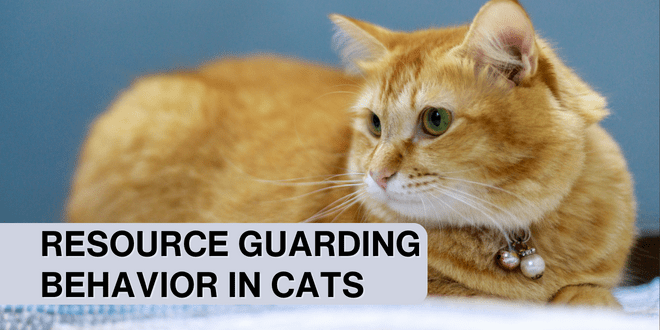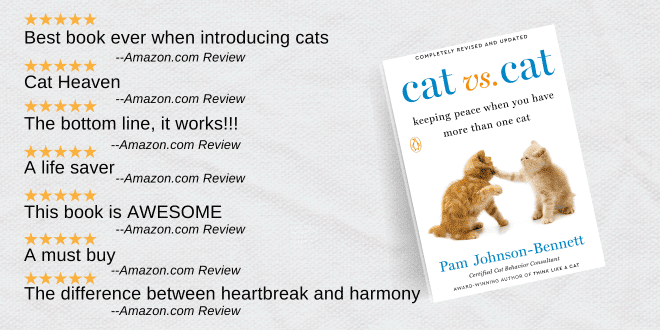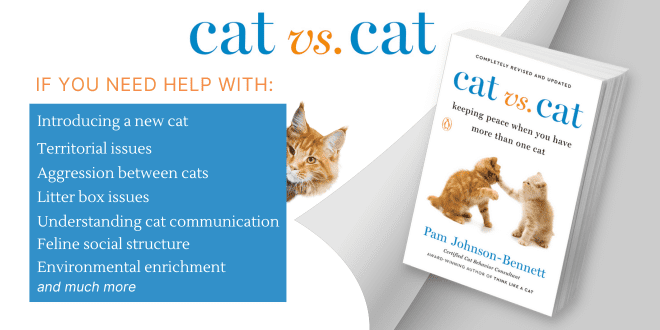
Being protective of resources is a natural instinct for all animals but it can become an issue when it creates stress, triggers aggression, and impacts the relationship of the companion animals in your home. Resource guarding can be triggered by a concern for the availability of food, favorite resting areas, toys, the litter box, and can even particular people in a cat’s life.
In some multicat homes, resource guarding behavior is very obvious. In other homes, it can be very hard to detect due to how subtle one or more of the cats are in the behavior display. The cats may look as if they get along, and in most aspects of their lives together they may not have any issues. There might be one or more situations though that do cause one cat to become protective over something.
Resource Guarding at the Cat’s Feeding Station
Probably the most common resource guarding behavior happens at the food bowl. Sometimes the sweetest cat can turn into a tiger when it comes to preventing feline companions from coming close to the food. the cat may just guard their own bowl or may guard all the bowls. If you feed out of one community food bowl the cat may guard the entrance to the kitchen. The guarding cat may push the other cats out of the way in order to eat first. In many situations where one cat has been repeatedly bullied at the food bowl, they may learn to just wait until the guard cat has finished eating. The intimidated cat may sit off to the side or may have learned not to enter the kitchen at all in order to avoid a physical confrontation.
Resource Guarding at the Litter Box
Resource guarding can also take place at the litter box and in some cases it can be extremely subtle to the cat parent. The cat may appear to be lounging in the middle of the hallway leading to the room where the litter box is located. the guard cat may look totally relaxed but in reality, what he might be doing is guarding the path to the litter box. For any companion cats to access the litter box they would have to walk past the feline guard.
Dealing with Resource Guarding at the Food Bowl
The best behavior technique for dealing with resource guarding is to offer choice. When cats have a choice they are less likely to become stressed and feel the need to defend an item.
In the case of the feeding station, set up food bowls in more than one location. If you’ve been feeding out of one common bowl, divide up the food into several dishes and spread them out. The resource guarding cat can’t be in all places at once. If the resource guarding was triggered by the cat having to share a bowl with another cat then set out more bowls in one location, and that may be enough. If the behavior is more severe and the intimidated cat won’t eat while the guard cat is in the same room then set up additional feeding stations around the house. Choose locations where intimidated cats naturally feel more comfortable. Place bowls on various vertical levels to help intimidated cats feel more secure because they can watch for any sign of another cat entering the room.
Use puzzle feeders during the day to give your cats something to do in order to earn food rewards. Hunting puts the cat in a good frame of mind and so having the opportunity to work for food and earn a reward may help relieve boredom, ease tension, quiet potential aggressive encounters, and it will prevent the cats from getting too hungry. Be sure to set up a good number of puzzle feeders throughout the house so every cat gets a chance to enjoy them.
Dealing With Resource Guarding at the Litter Box
As with the above example with the feeding station, choice plays a very important role here. Don’t put your cats in a tense situation by forcing them to have to share one box. Even if you’ve set up more than one box, if you put them all in the same room it still puts someone in the position of being able to engage in guarding behavior. Place boxes in multiple locations around the house so every cat has a comfortable option. When deciding where boxes should be located, choose areas where one cat won’t be forced to enter another cat’s location. Additionally, when you know you have a cat who does tend to guard, don’t place resources where other cats have to walk past a narrow opening (such as a long hallway) if you can avoid it.
Litter boxes should outnumber your cats by at least one and they should be scattered throughout the house so there’s one in each cat’s preferred core area.
Resource Guarding Can Happen in Many Situations with Cats
The key is always to provide choice and don’t put your cats in a situation where they are forced to share something. You may have a cat who grabs a toy during an interactive play session and intimidates the other cats into staying in the background. To avoid this, do your interactive sessions individually or use more than one toy.
Some Signs of Possible Resource Guarding
- A cat may hiss or growl when another cat (or anyone) comes close to a particular resource
- The cat may appear to be lounging but the facial expression will not look relaxed as they position themself in the path leading to a particular resource.
- A cat may be overt in resource guarding by standing directly in front of it to prevent another cat from gaining access.
- The guarding cat may stop moving and give a direct stare to anyone approaching the resource.
- A cat may take an overall offensive body posture to intimidate anyone who approaches.
- At the food bowl, a resource guarding cat may eat too fast to prevent any other cat from getting any of it.
Need More Information?
Resource guarding creates a lot of stress. Consult your veterinarian to make sure there isn’t a medical reason for the behavior. Your veterinarian may give you a referral to a veterinary behaviorist or a certified cat behavior consultant. A behavior professional can provide you with a behavior plan to address the resource guarding issue.
For more information on cat behavior and training, refer to the best-selling books by Pam Johnson-Bennett. Pam’s books are available at bookstores and online. We’ve included Amazon links on our website.
If you have a question regarding your cat’s health, please contact your veterinarian. This article is not intended as a replacement for your cat’s veterinary care.




